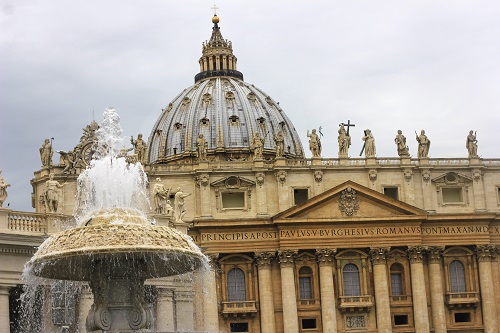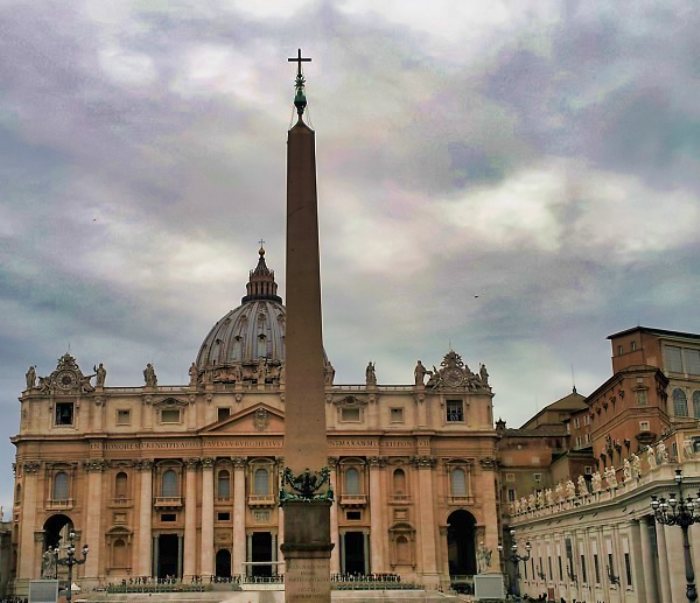
St Peter’s Basilica is the largest church in the world. Italy’s greatest architects built it in the Vatican over a period of a hundred years. The church was built during the period 1506–1626. Saint Peter, the chief apostle of Jesus Christ,died here in 64 AD and is buried under the central altar in the church. Saint Peter is looked upon as the first Pope.

Architecture of St Peter’s Basilica
The central dome of the church dominates the skyline of Rome. The dome was conceived by Michelangelo Buonarroti. Other principal designers were Donato Bramante, Carlo Maderno and Gian Lorenzo Bernini. St. Peter’s is reputedly the most famous work of Renaissance architecture. It is located in Vatican City, west of the River Tiber. The Vatican is completely surrounded by the city of Rome.

Saint Peter’s Square is the large open space in front of the church. Huge colonnades flank it. Gian Lorenzo Bernini designed the massive colonnades and one of the fountains. Carlo Maderno designed the other fountain. At the centre of the square is an Egyptian obelisk of red granite.

The obelisk is 25.5 metres tall and rests on bronze lions. It is surmounted by the arms in bronze of the Chigi princely family.
The colonnades define the piazza. The elliptical center of the square contrasts with the trapezoidal entrance area. The paving is varied by radiating lines in travertine limestone.

Gian Lorenzo Bernini and his team sculpted the 140 statues of saints that adorn the balustrades on the colonnades.

The Interior of St. Peter’s Basilica
Interiors of the church are enormous. The nave (the principal longitudinal area of the church) has a barrel-vaulted ceiling and is big enough to accommodate 20,000 people. The interior of St Peter’s Basilica contains beautiful monuments.

You will find the bronze statue of Saint Peter to the right of the altar. Arnolfo di Cambio built the statue in the thirteenth century. Pilgrims touch or kiss the saint’s foot.

The richness of the interiors is an indicator of the deep pockets of the catholic church in the sixteenth and seventeenth centuries.

In front of the papal altar is the confessio (burial crypt) which indicates the grave of Saint Peter. Around it a balustrade that has ninety-five bronze oil lamps.

The confessio is located right below the magnificent dome. If you look up you will see the colourful vaults with sixteen ribs on four heavy pillars. The triangular spaces where the pillars meet the dome display mosaics portraying the evangelists. Light enters through the lantern and the sixteen large windows below the cornice.

Getting Around in St. Peter’s Basilica
Entrance to the church is free. But St. Peter’s has a strict dress code: no shorts, no skirts above the knees and no bare shoulders. You have to pay a fee to go up the stairs. It is 5 euros for the stairs and 7 euros for the elevator. The elevator will take you to the roof level, bypassing 320 steps. But if you want to get to the top of the dome or cupola, you must climb the remaining steps. It is 511 steps in total. Entry timings are: 8:00 to 18:00 (Apr – Sep) and 8:00 to 16:45 (Oct – Mar).

The climb to the top of the dome moves through gradually narrowing stairs. The slender staircase can be claustrophobic. It could also get crowded and hot in summer. Luckily, there are occasional openings to allow fresh air in. You will have the interior lights plus sunlight streaming in through the openings.

When you reach the top, you can enjoy superb panoramic views. Mark Twain had said, “From the dome of St. Peter’s one can see every notable object in Rome…He can see a panorama that is varied, extensive, beautiful to the eye and more illustrious in history than any other in Europe.”

If you liked the post, you could…
Join more than 5,000 fans of UASATISH by liking us on Facebook, or follow us on Twitter and Instagram.